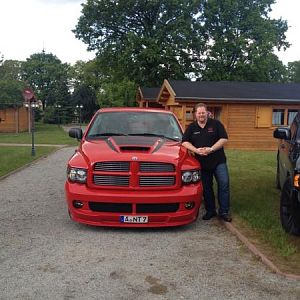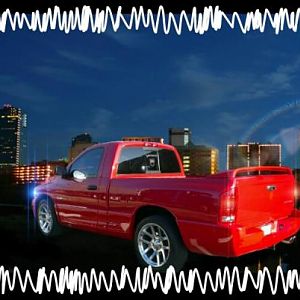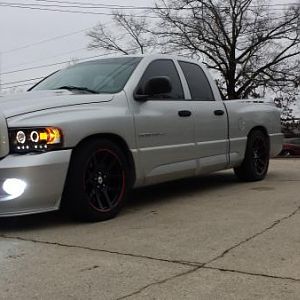okay, i was thinking the hose that originally went to the intake manifold was needed to pull a vacuum... now its not:dontknow:
You are using an out of date browser. It may not display this or other websites correctly.
You should upgrade or use an alternative browser.
You should upgrade or use an alternative browser.
roe blowing oil
- Thread starter pirateman
- Start date
Marc T
Full Access Member
AWDisuzu said:sorry, please forgive my drawing skills. for the supercharged guys, the blue hose needs to be on on the low pressure side of your intake so that it sees suction. basically, it needs to be right behind the air filter.
~mike~

This would be difficult with the Roe setup since the filter is attached directly to the TB.
Is it necessary to have suction on the clean side? Justins can comes with a filter that attaches to the clean side??
Mike, with all that is going on around you, taking time to provide this drawing is well above and beyond the call of duty...truly an act of love.
Thank you...and be safe.
Roy
Thank you...and be safe.
Roy
AWDisuzu
Full Access Member
this is correct, for a non-raced motor. during light cruise you have vacuum from the intake manifold on the suction side of the catch can. however, for a vehicle that's raced a lot or supercharged, you want the most suction you can get during wide open throttle (as this is when the pressure builds up and pops out the dipstick)
The ideal setup is to use 2 catch cans. I can post up other recommended configurations, however for the average racer the one I posted up is going to work really well.
I know the ROE has the air filter connected right to the throttle body, which is super because the roe sees boost below the intake plenum and you can actually run your blue hose to the intake plenum itself to pull lots of vacuum during cruise, and also have good suction under wide open throttle.
The paxton guys could do that too, if the throttle body was moved to the low pressure side of the supercharger. I've seen lots of turbo setups like this. It works well because you get 20+ inches of vacuum in your turbo compressor during cruise which allows the turbo impeller blades to spin up much faster when you stomp on the gas.
The ideal setup is to use 2 catch cans. I can post up other recommended configurations, however for the average racer the one I posted up is going to work really well.
I know the ROE has the air filter connected right to the throttle body, which is super because the roe sees boost below the intake plenum and you can actually run your blue hose to the intake plenum itself to pull lots of vacuum during cruise, and also have good suction under wide open throttle.
The paxton guys could do that too, if the throttle body was moved to the low pressure side of the supercharger. I've seen lots of turbo setups like this. It works well because you get 20+ inches of vacuum in your turbo compressor during cruise which allows the turbo impeller blades to spin up much faster when you stomp on the gas.
SANCHOBA said:okay, i was thinking the hose that originally went to the intake manifold was needed to pull a vacuum... now its not:dontknow:
AWDisuzu
Full Access Member
another common method (i just thought of) is to use a vacuum pump on the suction side. however, check your local race rules as I know vacuum pumps are not allowed in my class (street legal class) of racing.
I'm still kind of confused. With Justin's catch can you have a filter on the top. Do you need to tap the catch can and run another line to the air cleaner? I run a different CAI setup. What about the one way valve previously mentioned? Thanks again.
AWDisuzu
Full Access Member
There shouldn't be a filter on a catch can. Without the return hose, you don't have a complete circuit so to speak. You'll build up unwanted crankcase pressure, thereby forcing oil vapors into the catch can, but you don't need a catch can for that. The catch can is used to clean the air so that it can be sucked back into the intake. The factory setup is ideal, but oil vapors will develop when oil temps rise in the 210+ temperature range. These oil vapors are normally sucked into the intake and burned off. Burning oil vapors lower the octane of your fuel, so in extreme cases it can cause pinging.
This is all fine and dandy if you're running oil in the engine, but most of us run mobil 1 synthetic. Synthetic does not turn into vapor in the crankcase until it reaches 450 degrees. So, if you have a catch can installed and you're having to drain synthetic oil out of it, it's probably from excessive blow by "blowing" the oil into the can or possibly the catch can is hooked up wrong.
As for the check valve, that would be used when you have the "clean air" hose connected to the intake manifold vacuum.
Here's another diagram which includes check valves
~mike~

This is all fine and dandy if you're running oil in the engine, but most of us run mobil 1 synthetic. Synthetic does not turn into vapor in the crankcase until it reaches 450 degrees. So, if you have a catch can installed and you're having to drain synthetic oil out of it, it's probably from excessive blow by "blowing" the oil into the can or possibly the catch can is hooked up wrong.
As for the check valve, that would be used when you have the "clean air" hose connected to the intake manifold vacuum.
Here's another diagram which includes check valves
~mike~

blackviper said:I'm still kind of confused. With Justin's catch can you have a filter on the top. Do you need to tap the catch can and run another line to the air cleaner? I run a different CAI setup. What about the one way valve previously mentioned? Thanks again.
Mike I differ with you when you say "complete circuit". The purpose of my oil catch can is to lessen the oil spray that comes from my oil breathers. That spray contains oil and condensation...I have no need to re-inject it into the intake. I want to get rid of it via the catch can and not burn it off by putting it into the fuel air mixture. As you say too much can cause pinging by lowering the octane (I think it would take a significant amount to do that). I want to purge the blow-by created by the pressure that is already within the pressurized (drivers) side of the engine, rather than have it spray all over the place. I see absolutly no need to re-burn that water/oil mist...my engine in a normal configuration may do it for EPA considerations, but from my standpoint it is just a mess because we use breathers to expel it in forced induction systems.
You will have to re-state your reasons for the full-circuit if I have mis-construed your meaning...but why not just catch the blow-by and throw it away? That's what catch cans have done for 40 years...eliminate messy oil blow-by.
Maybe we are talking about different objectives?
You will have to re-state your reasons for the full-circuit if I have mis-construed your meaning...but why not just catch the blow-by and throw it away? That's what catch cans have done for 40 years...eliminate messy oil blow-by.
Maybe we are talking about different objectives?
AWDisuzu
Full Access Member
you might want to look into why you have oil/mist blowing out of there in the first place. you don't want to re-burn it, which is why a catch can is used to remove oil vapor.
Once you start seeing oil or any significant amount of pressure coming from the breather, it's time to investigate. Its possibly rings, but also could be a cracked piston. Maybe more than one cracked piston....
I'm not sure why you are only seeing splatter on the driver's side breather, the crankcase is not vented to only one side.
You really shouldn't be finding anything in the catch can if you're running synthetic oil and if you don't have any mechanical failures.
Once you start seeing oil or any significant amount of pressure coming from the breather, it's time to investigate. Its possibly rings, but also could be a cracked piston. Maybe more than one cracked piston....
I'm not sure why you are only seeing splatter on the driver's side breather, the crankcase is not vented to only one side.
You really shouldn't be finding anything in the catch can if you're running synthetic oil and if you don't have any mechanical failures.
Prof said:Mike I differ with you when you say "complete circuit". The purpose of my oil catch can is to lessen the oil spray that comes from my oil breathers. That spray contains oil and condensation...I have no need to re-inject it into the intake. I want to get rid of it via the catch can and not burn it off by putting it into the fuel air mixture. As you say too much can cause pinging by lowering the octane (I think it would take a significant amount to do that). I want to purge the blow-by created by the pressure that is already within the pressurized (drivers) side of the engine, rather than have it spray all over the place. I see absolutly no need to re-burn that water/oil mist...my engine in a normal configuration may do it for EPA considerations, but from my standpoint it is just a mess because we use breathers to expel it in forced induction systems.
You will have to re-state your reasons for the full-circuit if I have mis-construed your meaning...but why not just catch the blow-by and throw it away? That's what catch cans have done for 40 years...eliminate messy oil blow-by.
Maybe we are talking about different objectives?
I wonder if you have ever looked at the opening in the passenger side vent? It is tiny and there is almost no pressure on that side...and all viper engines are that way...I have had the same pressure on the drivers side from day one. Other experts are telling me that it is a persistent issue with these engines under boost. The mist varies greatly with the viscosity of the oil...moving to 15w40 significantly reduces the mist...using 0w30 or 10w30 has the opposite effect.
what about water?You really shouldn't be finding anything in the catch can if you're running synthetic oil and if you don't have any mechanical failures
AWDisuzu said:You really shouldn't be finding anything in the catch can if you're running synthetic oil and if you don't have any mechanical failures.
Well I was pretty much with you until the statement above...
I have a feeling that you may be a minority of one on this issue...any one else agree with Mike on this one?
AWDisuzu
Full Access Member
if your oil temperature gets hot enough, the moisture built up in the motor will boil away and collect in the catch can, so long as you have sufficient suction on the return line of the catch can. Catch cans have a filter in them, so without suction you won't get any flow. You do not want to rely on crank case pressure to PUSH fumes and moisture into the catch can because that's how you pop the dipstick, cause oil leaks, and that was the whole point of this post.
SANCHOBA said:what about water?
AWDisuzu
Full Access Member
The PCV system is crucial for to proper engine sealing. The system alleviates crankcase pressure, which can push out on seals and gaskets, contributing to oil leaks.
Oil leaks are one clue of a faulty PCV system. Leaking valve cover gaskets and rear main seals are but a few examples. If the PCV system isn't operating correctly, crankcase pressure can build and force oil past gaskets and seals that would have otherwise been OK.
Oil leaks are one clue of a faulty PCV system. Leaking valve cover gaskets and rear main seals are but a few examples. If the PCV system isn't operating correctly, crankcase pressure can build and force oil past gaskets and seals that would have otherwise been OK.
I'm totally lost...but I am getting used to being in this state. Back to my absent-minded professor mode.
I can't see how if I have two breathers on the driver side valve cover...how putting a catch can between the breather port and the breather will in any way increase pressure...and my catch can does not have any filter material. In essence all I have done is increase the distance the mist travels (and cools) before it exits through a breather filter. There is plenty of pressure from the drivers side to push the mist into the catch can...I get a slury of oil and what I believe is water...but now it is in the bottom of the catch can and not sprayed on my engine.
What PVC system? Are we talking about the Viper Engine?
I am obviously just too dense to understand this stuff...God forbid I ever have electrical problems!
I can't see how if I have two breathers on the driver side valve cover...how putting a catch can between the breather port and the breather will in any way increase pressure...and my catch can does not have any filter material. In essence all I have done is increase the distance the mist travels (and cools) before it exits through a breather filter. There is plenty of pressure from the drivers side to push the mist into the catch can...I get a slury of oil and what I believe is water...but now it is in the bottom of the catch can and not sprayed on my engine.
What PVC system? Are we talking about the Viper Engine?
I am obviously just too dense to understand this stuff...God forbid I ever have electrical problems!
AWDisuzu
Full Access Member
I am horrible at writing, so I'm sorry for being so confusing. First of all, you should definitely not have any pressure blowing out of it. Pressure comes from excessive blowby usually due to a cracked piston. It could be from worn rings, but I doubt anyone here has 75,000+ miles on their srt-10. Cracked pistons seem like a logical explanation especially on a supercharged truck using stock pistons.
Secondly, a catch can does have a filter in it. If yours does not, it's not really a catch can. I'm not sure what you have installed but perhaps you're in need of another solution.
I'd start off first with a leak down test. With that much oil and moisture coming out of your valve cover I'd be suspicions!
Secondly, a catch can does have a filter in it. If yours does not, it's not really a catch can. I'm not sure what you have installed but perhaps you're in need of another solution.
I'd start off first with a leak down test. With that much oil and moisture coming out of your valve cover I'd be suspicions!
BOOMER
Full Access Member
guys, help yourselves out by running TWO catch cans, or a filter system on EACH valve cover, and by all means DO NOT tee the valve covers together. if you just add up the CFM that this V10 engine pushes, you can NOT properly vent the engine by tee'ing both valve covers together. add any boost on to the eqaution, and you are more than doubling the capacity needed to vent the cases. you can and will have some light pressure coming out of the vent lines, thats physics, there is no such thing as a perfect seal, and the engine must push and pull air thru itself.
to say that there is no pressure below the pistons/rings is a false. no rings provide a perfect seal, and with friction, the peaks and valleys of a cylinder wall, and over 2000 psi at times, pressure will get past the rings. it happens
there is, as one piston rises another falls and there is tremedous windage, and the pressure does change depending on load, throttle position, rpm, ring flutter, engine oil viscosity, thermal dynamics, and enigne efficiency, and if it is boosted then that variable as well.
to say that there is no pressure below the pistons/rings is a false. no rings provide a perfect seal, and with friction, the peaks and valleys of a cylinder wall, and over 2000 psi at times, pressure will get past the rings. it happens
there is, as one piston rises another falls and there is tremedous windage, and the pressure does change depending on load, throttle position, rpm, ring flutter, engine oil viscosity, thermal dynamics, and enigne efficiency, and if it is boosted then that variable as well.
Last edited:
Boomer's comments are what I am hearing from two or three engine builders...they all except Mike seem to believe that the pressure from the left bank of the viper engine is normal and to be expected. Sean Roe suggested that a good demonstration of the pressure in the left side of the engine and the turbulence present can be viewed by looking into the oil filler port with the engine running...have a big towel in hand when you try this.....
Roy
Roy
BOOMER
Full Access Member
and some flush for your eye!Prof said:Boomer's comments are what I am hearing from two or three engine builders...they all except Mike seem to believe that the pressure from the left bank of the viper engine is normal and to be expected. Sean Roe suggested that a good demonstration of the pressure in the left side of the engine and the turbulence present can be viewed by looking into the oil filler port with the engine running...have a big towel in hand when you try this.....
Roy
i have watched video of internal engine cases when i worked for Yamaha. thats why when the R1 came out, we put large "windows" in each webbing to connect the cylinders together, so that each cylinder would "vent" better to allow each piston to rise a fall easier, and we always over ventilated the cases on the race team bikes to allow for better ring seal, and to allow the cases to blow down
Marc T
Full Access Member
Someone please give a diagram of the best pratical way to install the catch can or cans!!
Do they need to be mounted at any particular height?
If the left side is where the majority of pressure is, could we just run one can on that side with the Breather filler cap and cap off the other side??
This is how Roe set it up with the blower, with out the catch can!
What worries me is all this talk about pressure on the rings and seals!
Do they need to be mounted at any particular height?
If the left side is where the majority of pressure is, could we just run one can on that side with the Breather filler cap and cap off the other side??
This is how Roe set it up with the blower, with out the catch can!
What worries me is all this talk about pressure on the rings and seals!
Support Us
Become A Supporting Member Today!





